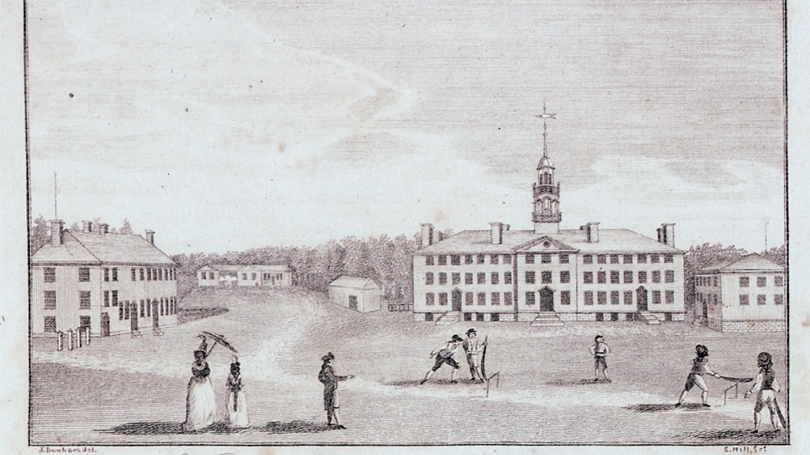
- Public Policy
- Leadership
- Funding
- News & Events
- About the Center
Back to Top Nav
Back to Top Nav
Back to Top Nav
Back to Top Nav
This article is part of a series honoring Dartmouth Alumni who have served in public office and demonstrated their commitment to the ideals of public service, leadership, and civic engagement.
Erastus Root graduated from Dartmouth in 1793, when the College was in its infancy. In fact, the first ever visual depiction of the college was produced in this year, which portrays students playing an early precursor to baseball on the Green. Root’s contemporary, Daniel Webster, wrote in private correspondence that he would “play ball” on the Green often during his days as a freshman on campus. While it is unclear how involved Root was in early sports at Dartmouth, it is well known that the Connecticut native was a prolific intellectual, with expertise in several academic fields.
Shortly after his graduation from Dartmouth, he wrote “An Introduction to Arithmetic,” which is believed to be the first comprehensive algebra textbook written and published by an American. He also obtained a medical degree from Dartmouth and even served as a Major General in the US Army. All in all, however, his most lasting legacy would be in the legal field, where he became known as a radical with respect to the breadth of libel laws in the United States. During his time as the Lt. Governor of New York (1823-1824), he established many precedents for state libel law that were later found unconstitutional as a violation of free speech guaranteed under the Constitution.
Root began his public career by winning a seat in the 8th US Congress in 1803, only ten years after his graduation from Dartmouth. He ran as a Democratic-Republican, the party of Thomas Jefferson. His first year in office coincides with the ratification of the Louisiana Purchase, which would drastically expand the territory of the United States from the Mississippi River westward to the Rocky Mountains. This land purchase would become the impetus for the ‘Manifest Destiny’ phenomenon that expanded the authority of the United States to the west coast.
Root would go on to serve three additional terms in Congress, from 1809-1811, 1815-1817, and 1831-1833. In 1815, Root even defeated prominent American statesman John Adams to win a seat in Congress. Throughout his time in the House, Root served as Chairman of the Committee on Claims, Expenditures in the War Department, and Agriculture. Congressman Root had quite a few fellow Dartmouth alums in the legislature with him; John Noyes and Luther Hewitt, both of the Class of 1795, served in the House with Root during his third term. Dudley Chase, Class of 1791, was completing his second term in the Senate during Root’s final term. All in all, Dartmouth has a rich legacy of presence in the national legislature throughout the early 19thcentury.
During his life, Root spent 30 total years in elected office, between serving in the New York State Assembly, the US Congress, and briefly as Lieutenant Governor of New York. He also has a strong legacy as a shaper of early American institutions. Joseph Henry, the first secretary of the Smithsonian, cited Erastus Root as a major “cultivator” of the Smithsonian system, as well as the National Institute for the Promotion of Science.
Erastus Root emerged from Dartmouth College during perhaps the most formative time in American political history, and he played no small part in shaping public policy that still affects Americans today. Despite his origins in Connecticut, Root’s lifelong service to the state of New York is a legacy that will not soon be forgotten; in fact, the town of Root in Montgomery County, NY, honors his namesake for posterity. Root’s career in law and public service is a shining example of the citizen-legislator that the Framers of the Constitution envisioned for our nation.
Written by Cameron Poole ’18, Student Researcher for the Dartmouth College Public Service Legacy Project.
"A Front View of Dartmouth College with the Chapel & Hall," drawn by Josiah Dunham (1769-1844); engraved by Samuel Hill (c. 1766-1804); published in the Massachusetts Magazine, February 1793. Images courtesy of Dartmouth College Library.